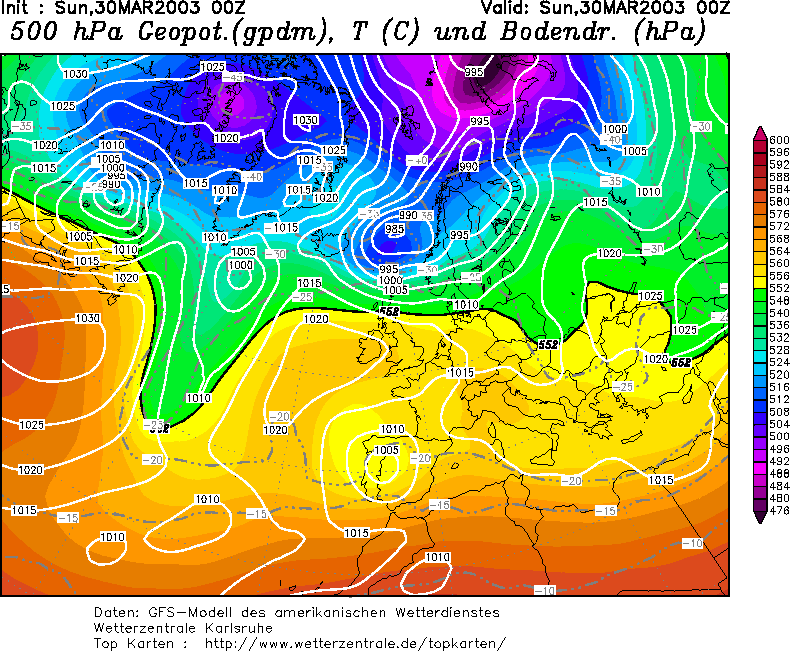|
Size: 2236
Comment:
|
Size: 3635
Comment:
|
| Deletions are marked like this. | Additions are marked like this. |
| Line 1: | Line 1: |
| == Daten == |
|
| Line 9: | Line 11: |
| == Skript == |
|
| Line 14: | Line 18: |
| #from mpl_toolkits.basemap import Basemap | from mpl_toolkits.basemap import Basemap |
| Line 25: | Line 29: |
| # Ausschnitt definieren sued=30 nord=0 west=130 ost=180 # Kartendarstellung # global figure(1) imshow(Temp[0,:,:],vmin=170,vmax=300) colorbar() show() # Ausschnitt figure(2) imshow(Temp[0,nord:sued,west:ost],vmin=170,vmax=300) colorbar() show() |
|
| Line 45: | Line 31: |
| testnan=Temp[0,nord:sued,west:ost] | testnan=Temp[0,:,:] |
| Line 48: | Line 34: |
| # Temperaturprofil figure(3) |
# Temperaturprofile figure(1) |
| Line 51: | Line 37: |
| plot(Temp[:,30,150],Lv) | plot(Temp[:,16,165],Lv) |
| Line 53: | Line 39: |
| title('over ice, lat=-15,lon=74') | |
| Line 55: | Line 42: |
| plot(Temp[:,25,150],Lv) | plot(Temp[:,16,192],Lv) |
| Line 57: | Line 44: |
| title('over open water, lat=12,lon=74') | |
| Line 58: | Line 46: |
| savefig('Soundings.png',dpi=75) # Kartendarstellung der vorhandenen Profile figure(2) m = Basemap(width=2400000,height=1600000,projection='stere',lat_ts=77.0,lon_0=15.0,lat_0=77.0,resolution='l') m.drawcoastlines() for i in range(0,30): for j in range(160,200): if testnan[i,j]==0: x,y=m(j-180.,90.-i) m.plot(x,y,'r.') x,y=m(-3.,77.) m.plot(x,y,'b.') x,y=m(10.,77.) m.plot(x,y,'b.') title('grid points with profiles(red), spectrum (blue)') show() savefig('Map.png',dpi=75) |
|
| Line 90: | Line 99: |
| * Drucklevels | * (./) Drucklevels |
| Line 92: | Line 101: |
| * MISSING Values | * (./) Karte mit vorhandenen Profilen - gibt es bei Wolken nie Daten? ja * (./) Daten zum testen: |
| Line 94: | Line 104: |
| * Koordinaten | [[http://rapidfire.sci.gsfc.nasa.gov/subsets/?subset=AERONET_Hornsund.2009073.terra.250m | 14.03.09]] |
| Line 96: | Line 106: |
| * Profile ploten | [[http://rapidfire.sci.gsfc.nasa.gov/subsets/?subset=AERONET_Hornsund.2009077.terra.250m | 18.03.09]] |
| Line 98: | Line 108: |
| * Grenzschichtdicke in hPa bestimmen | [[http://rapidfire.sci.gsfc.nasa.gov/subsets/?subset=AERONET_Hornsund.2009089.terra.250m | 30.03.09]] |
| Line 100: | Line 110: |
| * Grenzschichtdicke in Meter umrechnen (barometrische Höhenformel) | [[http://rapidfire.sci.gsfc.nasa.gov/subsets/?subset=AERONET_Hornsund.2009090.terra.250m | 31.03.09]] [[http://rapidfire.sci.gsfc.nasa.gov/subsets/?subset=AERONET_Hornsund.2009091.terra.250m | 01.04.09]] * (./) Koordinaten - von der Grenzschichtgruppe: Breite 77°-79°; Länge 2° bis 10° * (./) Profile plotten * (./) Grenzschichtdicke in hPa bestimmen: Werte: jeweils 14 Profile * (./) sind überhaupt Inversionen sichtbar? nein - Bodendruck herausfinden {{attachment:Rtavn00120030330.png}} * (./) Grenzschichtdicke in Meter umrechnen barometrische Höhenformel: {{{#!latex $\Delta z = \frac{R_L T}{g}ln\left(\frac{p}{p_s}\right)$}}} R=287,1J/kgK; Annahme: T=const.; p=Druckniveau der Wolkenobergrenze, ps=Bodendruck aus Karte (s.o.) |
Daten
Temperaturprofile: AIRS
Hilfreiche Links:
Skript
1 #!/bin/tcsh
2
3 from pyhdf import SD
4 from pylab import *
5 from mpl_toolkits.basemap import Basemap
6
7 fid=SD.SD('AIRS.2003.03.30.L3.RetStd001.v5.0.14.0.G07215021620.hdf')
8 T=fid.select('Temperature_A')
9 Temp=T.get()
10
11
12 #Drucklevel
13 Lv=[1000.0,925.0,850.0,700.0,600.0,500.0,400.0,300.0,250.0,200.0,150.0,100.0,
14 70.0, 50.0,30.0, 20.0, 15.0, 10.0, 7.0,5.0, 3.0,2.0,1.5,1.0]
15
16
17 # Fehlende Profile finden - Wert 1
18 testnan=Temp[0,:,:]
19 testnan=testnan<0
20
21 # Temperaturprofile
22 figure(1)
23 subplot(1,2,1)
24 plot(Temp[:,16,165],Lv)
25 ylim((1000.0,1.0))
26 title('over ice, lat=-15,lon=74')
27 show()
28 subplot(1,2,2)
29 plot(Temp[:,16,192],Lv)
30 ylim((1000.0,1.0))
31 title('over open water, lat=12,lon=74')
32 show()
33 savefig('Soundings.png',dpi=75)
34
35 # Kartendarstellung der vorhandenen Profile
36 figure(2)
37 m = Basemap(width=2400000,height=1600000,projection='stere',lat_ts=77.0,lon_0=15.0,lat_0=77.0,resolution='l')
38 m.drawcoastlines()
39
40 for i in range(0,30):
41 for j in range(160,200):
42 if testnan[i,j]==0:
43 x,y=m(j-180.,90.-i)
44 m.plot(x,y,'r.')
45
46 x,y=m(-3.,77.)
47 m.plot(x,y,'b.')
48 x,y=m(10.,77.)
49 m.plot(x,y,'b.')
50 title('grid points with profiles(red), spectrum (blue)')
51
52 show()
53 savefig('Map.png',dpi=75)
Drucklevel:
Index of T |
|
Levels |
in mb of T Levels |
1 |
1000.0 |
2 |
925.0 |
3 |
850.0 |
4 |
700.0 |
5 |
600.0 |
6 |
500.0 |
7 |
400.0 |
8 |
300.0 |
9 |
250.0 |
10 |
200.0 |
11 |
150.0 |
12 |
100.0 |
13 |
70.0 |
14 |
50.0 |
15 |
30.0 |
16 |
20.0 |
17 |
15.0 |
18 |
10.0 |
19 |
7.0 |
20 |
5.0 |
21 |
3.0 |
22 |
2.0 |
23 |
1.5 |
24 |
1 |
Notizen
 Drucklevels
Drucklevels  Karte mit vorhandenen Profilen - gibt es bei Wolken nie Daten? ja
Karte mit vorhandenen Profilen - gibt es bei Wolken nie Daten? ja  Daten zum testen:
Daten zum testen:  Koordinaten - von der Grenzschichtgruppe: Breite 77°-79°; Länge 2° bis 10°
Koordinaten - von der Grenzschichtgruppe: Breite 77°-79°; Länge 2° bis 10°  Profile plotten
Profile plotten  Grenzschichtdicke in hPa bestimmen: Werte: jeweils 14 Profile
Grenzschichtdicke in hPa bestimmen: Werte: jeweils 14 Profile  sind überhaupt Inversionen sichtbar? nein - Bodendruck herausfinden
sind überhaupt Inversionen sichtbar? nein - Bodendruck herausfinden

 Grenzschichtdicke in Meter umrechnen barometrische Höhenformel:
Grenzschichtdicke in Meter umrechnen barometrische Höhenformel: latex error! exitcode was 2 (signal 0), transscript follows:
R=287,1J/kgK; Annahme: T=const.; p=Druckniveau der Wolkenobergrenze, ps=Bodendruck aus Karte (s.o.)
